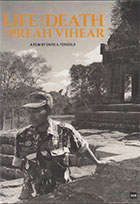
Life and Death at Preah Vihear 2015
Distributed by Documentary Educational Resources, 101 Morse Street, Watertown, MA 02472; 617-926-0491
Produced by Ophidian Films
Directed by David A. Feingold
DVD, 51 min., color, English, Khmer, and Thai with English subtitles
High School - General Adult
Asia, History, International Relations, Post Colonialism, Travel and Tourism
Date Entered: 01/05/2017
Reviewed by Jason R. Harshman, University of IowaLife and Death at Preah Vihear centers around perspectives from within Southeast Asia, offering a counter-narrative to the too often U.S.-centric version of what transpired in the region during the latter half of the twentieth century. At the heart of the web of conflict over ownership of the 11th century temple of Preah Vihear that exists between Thailand and Cambodia, is the more than a century old decision by French map makers to place the temple on the south side of the arbitrarily drawn border between the two nations. The film weaves the legacy of colonialism, citizens’ devotion to religion and national pride, and the relationship between international and national politics to explain why tensions around ownership of Preah Vihear have led to violence.
A brief history of the colonial powers that organized Southeast Asia is provided at the outset: Britain in Burma and France in Cambodia, Vietnam, and Laos. Thailand, referred to in the video as Siam, was the only nation free from colonial rule following WWII. The narrative for the region is grounded in a critical reading of how power was exercised through geography and the construction of nations based on the European concept of borders. The opening segments on how the SE Asian nations were shaped according to the designation of borders is central to the debate over Preah Vihear that has lasted for more than a century. When a case regarding ownership of the temple was brought before the World Court, the presiding officials, which represent the very colonial powers who created the issue, a decision was rendered that granted ownership to Cambodia based on the very maps that were under dispute.
A second factor underlying the devotion of people in Thailand and Cambodia to claiming ownership of Preah Vihear is religion and spirituality. Cambodia, as a Buddhist nation, is also rich in Hindu traditions and a cultural tapestry that includes an array of spiritual cults as well. Of the three factors identified above—geography, religion, and politics—this is the one that receives the least amount of attention. While there is a segment on the elevation of General Dee to quasi-deity and the organization of spiritual cults, religious devotion is superseded by nationalism amongst the people of both nations.
Most of the documentary focuses on how international politics shaped domestic politics, primarily the rise and fall of national leaders. Though the legacy of colonialism, the Khmer Rouge, and Vietnam War carry great significance in the area, the decision by UNESCO to designate Preah Vihear as a World Heritage site that belongs to Cambodia receives the most attention from filmmakers. Public demonstrations, border conflicts, political elections, and the displacement of thousands of people in both countries are all tethered to the 2008 UNESCO decision. Recent footage of demonstrators is mixed together with interview excerpts with former Prime Ministers, academics, government officials, and citizens who have volunteered to fight on behalf of their country for the temple.
The long conflict over the temple has led to the displacement of thousands of people as well as physical damage to the temple. The narrator claims the physical fighting has ceased, however, a standoff between citizens on both sides continues along the border. The 2016 ascension of a new King in Thailand and the continued animosity between the people of Cambodia and their government makes this film a useful teaching tool for high school and college classrooms that examine geopolitics, world history, and contemporary world issues.